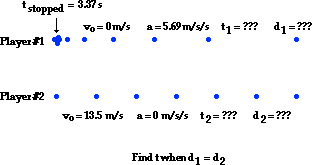Mechanics: 1-Dimensional Kinematics
1-Dimensional Kinematics: Audio Guided Solution
Extra Problem 9:
A 72-kg hockey player is standing on his skates on a frozen pond when an opposing player moving with a uniform speed of 13.5 m/s skates by with the puck. After 3.37 s, the first player makes up his mind to chase his opponent. If he accelerates uniformly at 5.69 m/s/s, how much time (in seconds) does it take him to catch his opponent? (Assume that the player with the puck remains in motion at constant speed.)

Audio Guided Solution
Read About It!
Get more information on the topic of 1-Dimensional Kinematics at The Physics Classroom Tutorial.
Return to Original Problem Set
Return to Index of Extra Problems
Return to Overview
Habits of an Effective Problem Solver
An effective problem solver by habit approaches a physics problem in a manner that reflects a collection of disciplined habits. An effective problem-solver...
-
...reads the problem carefully and develops a mental picture of the physical situation. If needed, they sketch a simple diagram of the physical situation to help visualize it.
-
...identifies the known and unknown quantities in an organized manner, often times recording them on the diagram iteself. They equate given values to the symbols used to represent the corresponding quantity (e.g., vo = 0 m/s; a = 4.2 m/s/s; vf = 22.9 m/s; d = ???.).
-
...plots a strategy for solving for the unknown quantity; the strategy will typically center around the use of physics equations be heavily dependent upon an understaning of physics principles.
-
...identifies the appropriate formula(s) to use, often times writing them down. Where needed, they perform the needed conversion of quantities into the proper unit.
-
...performs substitutions and algebraic manipulations in order to solve for the unknown quantity.